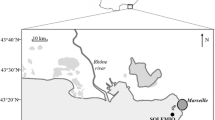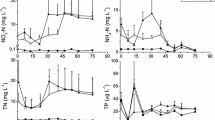Abstract
The investigation of the bacterial community in the Kühwörter Wasser, a macrophyte-dominated arm of the River Danube backwater system near Vienna, revealed that variation in microbial densities and biomass could be related to a characteristic sequence in morphotype composition over the seasons. Maximal bacterial cell numbers and biomass occured in early summer, with values of up to 9 × 109 cells l−1 and 122 μg C l−1, respectively, caused by a massive increase of vibrio-shaped cells. On the other hand, in early spring, filamentous bacteria were responsible for a marked increase in bacterial biomass, making up 40% of the total bacterial biomass. Over the year, rod-shaped cells were the dominating morphotype, while the biomass of cocci was rather negligible. In winter, cell numbers and biomass showed minimal values with 2.0 × 109 cells l−1 and 28 μg C l−1, respectively, and bacteria were considered to be substrate and temperature limited during this period. Saturation values of the incorporation of 3H-thymidine into DNA, for the estimation of bacterial secondary production, varied seasonally, ranging from 5 nm to 40 nm. Thus, saturation experiments needed to be conducted on a regular basis. Also, the amount of labeled thymidine in the DNA, as a percentage of labeled thymidine in the TCA precipitate, varied over the year. Minimum values of 45% were recorded during the cold season, while maximum values of 75–80% at the beginning of June coincided with high chlorophyll a values and minimal K m-values derived from saturation experiments. The potential role of the nitrogen-rich nucleoside thymidine as a readily utilizable substrate for bacteria during labeling experiments, under varying conditions of substrate availability, is discussed. Bacterial secondary production rates ranged from 0.3 μg C l−1 h−1 in winter to values of 10 μg C l−1 h−1 in August, where phytoplanktonic biomass reached the summer maximum, and bacterial biomass was calculated to be renewed 3 times per day. An estimation of the bacterial carbon demand showed that for the major part of the year, with the exception of early spring, the bacterioplankton community in the Kühwörter Wasser was dependent on carbon sources other than phytoplanktonic primary production.
Similar content being viewed by others
Author information
Authors and Affiliations
Additional information
Received: 22 March 1996; Revised: 1 August 1996
Rights and permissions
About this article
Cite this article
Kirschner, A., Velimirov, B. A Seasonal Study of Bacterial Community Succession in a Temperate Backwater System, Indicated by Variation in Morphotype Numbers, Biomass, and Secondary Production . Microb Ecol 34, 27–38 (1997). https://doi.org/10.1007/s002489900031
Published:
Issue Date:
DOI: https://doi.org/10.1007/s002489900031




